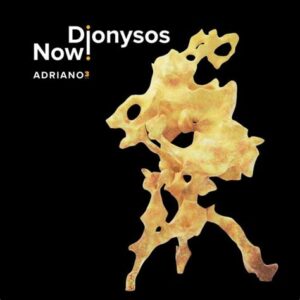Program: #24-07 Air Date: Feb 12, 2024
To listen to this show, you must first LOG IN. If you have already logged in, but you are still seeing this message, please SUBSCRIBE or UPGRADE your subscriber level today.
The recently-formed Ghent-based ensemble Dionysos Now! has taken on another in one of those remarkable projects: the complete sacred music of Adrian Willaert. Volume 4 includes the St. John Passion.
NOTE: All of the music on this program comes from the Ensemble Dionysos Now! directed by Tore Tom Denys. It is on Evil Penguin label and is available as a vinyl disc at number EPRC 0043. For more information on the ensemble: https://www.dionysosnow.com/en/home.
With this project Tore Denys wants to return to his roots in Roeselare and pay homage to one of the greatest composers in Roeselare's history. Together with the members of his ensemble Dionysos Now!, he wants to plan a trajectory to have a contemporary reflection of his most striking signature works in 2022 - 460 years after the death of Adriaan Willaert.
Adriaen Willaert must have already been a prolific composer before he assumed the position of kapellmeister at the Basilica of San Marco in Venice. After all, a second Mass of his was included in a large, illuminated choral manuscript that was produced for the Illustrious Brotherhood of Our Blessed Lady in 's-Hertogenbosch, the Netherlands (the first Mass in this manuscript, Missa sex vocum super “Benedicta,” can be found on the LP Adriano 2). The title page of the Mass does not mention the name of the composition, only that of the composer, Adrianus Willart. It was cataloged as a Missa sine nomine, a Mass without a name.
It is assumed that the work was composed between 1522 and 1527, at a time when Willaert was a member of the music chapel of Cardinal Ippolito d'Este in Ferrara, Italy. At first glance, what’s striking about this composition is that one of the tenor voices sings a cantus firmus (a “given, fixed, foundational voice” that provides the basis for each movement of the Mass, to which the other voices are added) that always consists of the same 13 notes: mi ut mi sol mi ut fa mi fa mi re mi.
In an article about the Mass, the musicologist Joshua Rifkin claims to have discovered a sogetto cavato delle parole in this sequence of notes. This is a compositional technique common for the time in which the notes of a melody, in this case the cantus firmus, are derived from the vowels of certain words. The notes used for the tone poetry are those of the Guidonian hexachord, a series of the 6 notes ut-re-mi-fa-sol-la. For example, the word Maria (Ma-ri-a) can be "translated" into the notes la mi la.
The cantus firmus of the Mass, according to Rifkin, fits the words “Primus Ippolitus Cardinalis Estensis” (Ippolito I, Cardinal d'Este) perfectly. The Mass is thus almost certainly (via a hidden message in the music) an ode to the Cardinal of Ferrara who was Willaert’s patron. This rediscovered untitled Mass by Adriaen Willaert, which we have now sung as a world premiere, can therefore rightly bear the name Missa Ippolito.
Tore Tom Denys: Adriaen Willaert’s little-known St John Passion is his only surviving setting of the Passion of Christ. With this recording, I want to prove that a compositional innovation took place in the Renaissance that aimed to make the recitation of the Passion on Good Friday (which was then traditionally sung in unison, Gregorian chant) more musically interesting. The passion is composed in an innovatively polyphonic, but homo-rhythmical manner: every voice sings the same text at the same time. This way, the text remains very intelligible, and the listener is captivated by the way the story is presented.
All the “roles” that appear in his St John Passion are set in a polyphonic manner. The part of the Evangelist is worked out in four voices; Jesus in three voices; Pilatus, Ancilla, and Petrus in two voices; and the crowd (turba) in six voices. Afther the death of A. Willaert, this work has probably never been performed in its original form, as can be found in the part books (manuscripts, not printed).
The “simple”, lean and listener-understandable way in which these passions were composed, could be a consequence of the recommendations and restrictions imposed on the composers by their superiors, who at the Council of Trente (1545–1563) were looking for solutions to make the liturgy more attractive. In this, music played a major role.
01. Quando di rose d’oro, 02:28
02. Missa Ippolito: I. Kyrie, 03:23
03. Missa Ippolito: II. Gloria, 04:47
04. Missa Ippolito: III. Credo, 07:15
05. Missa Ippolito: IV. Sanctus, 06:17
06. Missa Ippolito: V. Agnus Dei, 04:22
07. Haud aliter pugnans, 02:42
08. Adriacos numero, 05:01
09. Qui boyt et ne reboyt, 00:54
(Adriaen Willaert) Dionysos Now!
01. Passio Domini nostri Jesu Christi secundum Joannem - part 1, 19:01
02. Passio Domini nostri Jesu Christi secundum Joannem - part 2, 19:11
(Adriaen Willaert) Dionysos Now!
01. Passio Domini nostri Jesu Christi secundum Joannem - part 3, 11:16
02. Ecce lignum crucis - Crux fidelis, 05:39
03. Tristis est anima mea, 03:32
04. Infelix ego, 06:44
05. Flete oculi, 04:12
06. Dulces exuviae, 03:50
07. Da pacem Domine, 02:28
(Adriaen Willaert) Dionysos Now!(Adriaen Willaert) Dionysos Now!
Composer Info
Adriaen Willaert
CD Info
Evil Penguin label vinyl disc EPRC 0043
